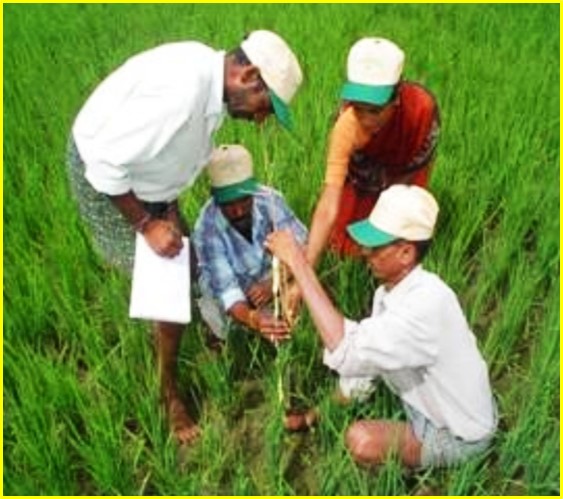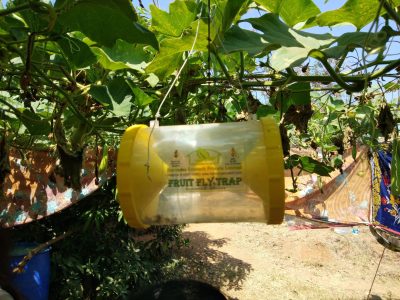Pests and pesticides present a significant challenge in agriculture, leading to substantial losses for farmers. The widespread use of monocultures and increased reliance on chemical pesticides has disrupted the ecological balance, triggering pest outbreaks. This has led to the resurgence and resistance of pests, while pesticide residues in the air, soil, water, and food pose serious environmental and health risks.
Addressing this issue requires more than simply substituting one chemical with another or replacing chemical pesticides with biopesticides or herbal concoctions. A new ecological pest management framework is needed, one that focuses on restoring ecological balance through changes in cropping patterns and farming practices.
Non-Pesticidal Management (NPM) is one such approach that enables farmers to control pests without using chemical pesticides. The Centre for Sustainable Agriculture has been a pioneer in developing and promoting this model in collaboration with farmers, grassroots organizations, and through various programs across the country since 2004.
Since its implementation in 2005-06, NPM has gained widespread acceptance among academics, development organizations, and those practicing agroecology. Over time, the NPM approach has evolved based on the challenges encountered, lessons learned, and resource limitations in different regions. With these insights, the course is designed to equip frontline workers and resource persons with the knowledge to implement this approach with farmers.
After completing the training, participants will be able to apply their learning in their areas of work. Our digital field schools offer ongoing support, providing fortnightly interactions, suggestions, and solutions to challenges that participants may face in the field.
Medium of Instruction: English
Course Format: Self-learning and online live sessions
- Total Course Duration: 30 hours
- Self-learning modules: 20 hours (text and video content)
- Interactive sessions: 10 hours of live Zoom sessions, conducted weekly (3 days, 3:00 PM – 6:00 PM; schedule provided upon registration)
- Boot camp: Participants have the option to attend a boot camp for hands-on practice or join an on-campus course at a discounted rate.
Course Features
- Lectures 71
- Quizzes 11
- Duration Lifetime access
- Skill level All levels
- Language English
- Students 63
- Assessments Yes
Curriculum
- 12 Sections
- 71 Lessons
- Lifetime
- Section 1: Current Paradigm of Pest Management and issuesUnderstanding insect Pests, Problems with current model pest management, Impacts of monocultures of crops, pesticides and disturbance in agroecology etc, understanding Integrated Pest Management (IPM), Insecticide Resistance Management (IRM)6
- 1.1NPM-101: Introduction to Non Pesticidal Management
- 1.2NPM-102: Pesticide induced pest problems
- 1.3NPM-103: Pests, Pesticides and Distress
- 1.4NPM-104: Pesticide Regulation in India
- 1.51st Section: Current Paradigm of Pest Management and issues10 Minutes0 Questions
- 1.61st Section: What is your experience with pesticides3 Days
- Section 2: Managing the problem: Integrated Pest Management2
- Section 3: Genetically modified crops in pest, disease and weed management: issues and concernsIssues with Genetically Modified Crops, Biosafety, Pest management paradigm with Insecticidal protiens, Lessons learnt from Bt Cotton,11
- 3.1GMO-101: What is Genetic Engineering?
- 3.2GMO-102: Genetically Modified Crops in Pest, Disease and Weed Management
- 3.3GMO-103: Insect resistant (Bt) crops and issues
- 3.4GMO-104: Two decades of Bt cotton in India: Lessons learnt
- 3.5GMO-105: Herbicide Tolerant Cotton and impacts
- 3.6GMO-106: Genetically Modified Food Crops
- 3.7GMO-107: Bt brinjal-the controversies and the moratorium
- 3.8GMO-108: GM Mustard and Concerns
- 3.9GMO-109: Biosafety Issues and Regulatory System of GM Crops in India
- 3.10GMO-110: Labelling and Consumer Choices
- 3.112nd Section: Genetically modified crops in pest, disease and weed management: Issues and concerns10 Minutes0 Questions
- Section 4: Understanding Non Pesticidal ManagementFundamental principles of using agroecological approaches to pest and disease management5
- Section 5: Pest Surveillance, Diagnosis and AdvisoriesPest and disease surveillance, Pest and disease diagnostic tools12
- 5.1NPM-114: Field Diagnosis of Insect Pests and Diseases
- 5.2NPM-115: Identifying insect pests
- 5.3NPM-116: Identifying plant diseases
- 5.4NPM-117: Identifying nutrition deficiency symptoms
- 5.5Crop Advisories for pest and disease management
- 5.6eKrishi Pestoscope
- 5.7PestSmart
- 5.85th Section: Tools for pest and disease monitoring-Pestoscope, pestSmart10 Minutes0 Questions
- 5.9Pest and Disease Monitoring: Farm and Ecosystem Level
- 5.10Identifying crop weeds
- 5.11Plantix
- 5.12NPM-118:
- Section 5: Managing Insect Pests through NPM approachImpact of climate change on the pest and diseases8
- 6.1Disturbance in Agroecosystems: when insects become pests
- 6.2Decreasing the risk of crop failures and building resilience
- 6.3Role of Natural Enemies in Pest Management
- 6.45th Section: Managing Insect Pests through NPM Approach10 Minutes0 Questions
- 6.5Identifying Insects and Understanding their Behavior and Life Cycles
- 6.6Agroecology and Pest Management
- 6.7Major Insect Pests and their Management
- 6.8Managing Stored Grain Pests
- Section 6: Plant Disease Management through NPMUnderstanding plant diseases, Soil health and Plant diseases, Disease spread and their Management11
- 7.1What is plant disease?
- 7.26th Section: Plant Disease Management through NPM10 Minutes0 Questions
- 7.3Plant diseases and their management
- 7.4How to identify the plant disease?
- 7.5Fungal diseases in plants
- 7.6How disease spread?
- 7.7Soil health and plant diseases
- 7.8Bacterial diseases in plants and management
- 7.9Viral Disease in Plants and management
- 7.10Nematode diseases in plants and management
- 7.11Identifying Plant Diseases and their Management
- Section 7: Weeds in crop ecosystem and their management through NPMWhat are weeds, why plants becomes weeds, soil types and weeds, crop micro climate and weeds6
- Section 8: Crop wise pest and disease managementCrop wise pest management10
- 9.1Paddy
- 9.2Pulses: Redgram, Bengal gram, Blackgram
- 9.3Oilseeds: Groundnut, Soybean, Sunflower, Sesame, Safflower
- 9.4Fruits: Mango, Banana,
- 9.5Vegetables: Tomato, Brinjal, Gourds, Cabbage, Cauliflower
- 9.6Spices and Condiments: Chillies, Turmeric, Ginger, etc.
- 9.7Wheat
- 9.8Maize
- 9.9Millets
- 9.108th Section: Crop wise pest and disease management10 Minutes0 Questions
- Section 9: Farm Made botanicals and microbials and their use in pests and disease managementUnderstanding basics of pest and disease management using locally available resources4
- Section 10: Bioenterprises and commercial organic formulations for pest and disease managementBioEnterprises for production of bioinputs, Commercial organic formulations, role of traps etc4
- Section 11: Organising Farmer Field Schools for teaching Non Pesticidal ManagementTeaching agroecological approaches, Farmer Field Schools etc4
Target audiences
- Farmers
- Field Staff
- Enterpreneurs
- Students
- Teachers


